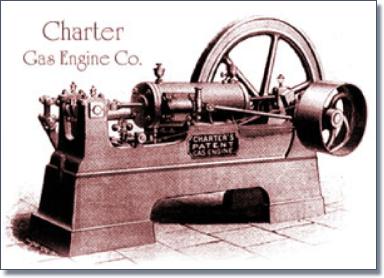|
The gas engine is one of the wonders of the 19th century. Now, within three years of the 20th century, it is a novel machine, eagerly sought by many people. It is thought by persons who have not studied its principles that it is a steam-engine, using gas or gasoline as fuel for the purpose of making steam. This is erroneous. Gas and gasoline in specific proportion with air are explosive material.
The expansive force derived from explosion of these materials in the cylinder is the force that is substituted for the expansive force of steam. Hence, owing to the economy of this method as a means of deriving power, the steam engine and boiler are fast disappearing, and the Gas Engine is taking their place for small power.
|
|
|
It is not generally known that the conception of the gas engine for the production of motive power antedates that of the steam engine. Nevertheless such is the case. It was not until the year 1744 that James Watt ran his first successful steam engine at the Soho Works, Birmingham, England, while Huyghens, Papin and other scientists had produced power in the seventeenth century by the explosion of chemicals and the expansive force of heated vapors.
But the mechanical difficulties proved too great, and so little was known in that age of economical methods of producing gas as fuel for the production of heat, that when the apparently more simple method of using the expansive force of steam produced by the evaporation of water by heat produced by the combustion of coal or wood was discovered, and Watt constructed his engine for utilizing steam, all further efforts in the direction of producing power by other heated vapors were suspended. For a century and a half the intelligence and genius of the world have been expended in improving the steam engine, until it is now conceded that it is as perfect as human effort can make it. No further economy in producing power by this method can be accomplished.
After careful and intelligent tests by experts with the best instruments made at the present day, it is generally admitted that what is now deemed the perfect steam engine does not convert more than 10 per cent of the heat efficiency into indicated work, and that ordinary engines and boilers do not realize over 4 per cent.
|
|
|
From 85 to 96 per cent of energy is lost in the wasteful methods of production steam through a boiler, and the condensation and friction in conveying it to the piston of the engine where the energy is expended in work. Compare this with the effective energy produced by the expansive force of heated vapor produced by the combustion of gas in the cylinder of the engine, without any intervening throttling by friction, cooling and condensation. We have immediately gained from 10 to 20 per cent of effectual energy from the heat units produced.
A century elapsed after the experiments of Huyghens in 1680, and Papin in 1690, before any further improvement or experiments are recorded in this direction.
Soon after steam had been successfully used, attention was again directed to the gas engine, and we find that Robert Street obtained a patent in 1794, and Lebon in 1801. In 1823 Samuel Brown constructed a gas engine that ran a boat successfully on the Thames and a road carriage on the streets of London.
|
|
|
W. L. Wright in 1835, and Barnett in 1838, made several important improvements. Then come Ador, Johnson, Robinson, Reynolds, Brown, Bolton, Webb, Newton, Edington, Barsanti, and Matteucei in the order named, who lend their aid in attempts to improve the machine. But it is not until 1860 that the mechanical difficulties are surmounted and a commercial gas engine constructed.
Lenoir then brought the gas engine out of the experimental stage into public use, and the Reading Iron Works Co. of the U.S. built 100 of them, and several of these engines are in use at the present time. Next in line comes Hugon in 1865, and Otto and L. Langen in 1867, followed by McGreggor, Bulkeley, Clerk, Crossley, and Bisschop and others.
Many years of constant application, labor, study, and experiment, with the usual discouragements and trials, have finally culminated in bringing out an engine that equals the finest steam engine of today.
|
|
|
It is only a matter of time when the prejudice that, as usual, exists against any innovation, the ungrounded fear of explosions and other difficulties, will be overcome and the superiority of the gas engine over the wasteful steam engine and boiler will be established. The unsightly smoke stacks, belching forth smoke and soot, will be relegated to the scrap heap, and the iron will be used to construct more useful machines. The atmosphere of our manufacturing cities will be as clear as that of the country. The cost of production power will be so reduced that the beggar may ride, and in the next decade the steam engine will occupy the same relative position to the gas engine that the flint and steel now do to the lucifer match, the tallow dip to the electric light, the stage coach to the bicycle, motor cycle, or the modern electric street cars, and civilization will record another grand stride toward the millenium.
|
|
 |
|